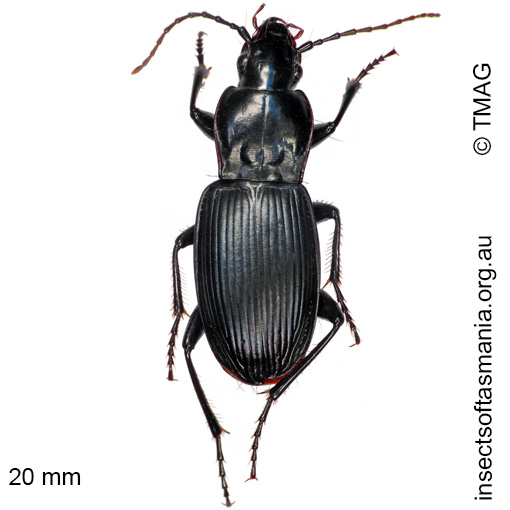
Rhabdotus reflexus
Basis for Tasmanian occurrence
TMAG collections
Classification
Suborder: Adephaga
Superfamily: Caraboidea
Family: Carabidae
Subfamily: Harpalinae
Tribe: Pterostichini
Morphology
Flightedness: (not yet documented)
Source literature on morphology and taxonomy (*primary taxonomic source, where identified):
Sloane, T.G. (1920). The Carabidae of Tasmania. Proc. Linn. Soc. NSW 45: 113-178.
Ecology
Association with dead wood or old trees: at least facultatively saproxylic
Ecological attributes: — Able to recolonise regrowth (Taylor & Doran, 2001) — Active primarily in spring-summer (Michaels & McQuillan, 1995) — Affiliated with intermediate-aged (ex-clearfelled) forest (Michaels, 1999) — Affiliated with late-aged (ex-clearfelled) forest (Michaels, 1999) — Affiliated with mature (unlogged) forest (Grove, 2009) — Affiliated with mature (unlogged) forest (Michaels, 1999) — Affliliated with mature (unlogged) forest (Baker et al., 2009c) — Associated with both older logging-regenerated and mature (unlogged) forest (Taylor et al., 2000) — May occupy logs or trunks of Eucalyptus obliqua, at least temporarily, since found having emerged within a year of felling (Grove & Bashford, 2003) — May occupy logs or trunks of Eucalyptus obliqua, at least temporarily, since found having emerged within six years of felling (Grove et al., 2009).
Collection method(s) for TMAG material: — Emergence trapping from log of Eucalyptus obliqua — Hand collection (substrate not specified) — Hand collection from under log of Eucalyptus sp. — Pitfall trapping.
Source ecological literature:
Grove, S.J. & Bashford, R. (2003). Beetle assemblages from the Warra log decay project: insights from the first year of sampling. Tasforests 14: 117-129.
Grove, S.J. (2009b). Beetles and fuelwood harvesting: a retrospective study from Tasmania’s southern forests. Tasforests 18: 77-99.
Grove, S.J. et al. (2006). What lives under large logs in Tasmanian eucalypt forest? Tas. Nat. 128: 86-93.
Baker, S.C. (2000). Forest litter beetles and their habitat: a comparison of forest regenerated by wildfire and logging practices. Hons. thesis, Univ. of Tasmania, Hobart.
Baker, S.C. (2006b). Ecology and conservation of ground-dwelling beetles in managed wet eucalypt forest: edge and riparian effects. PhD thesis, Univ. of Tasmania, Hobart.
Grove, S. et al. (2009). A long-term experimental study of saproxylic beetle … succession in Tasmanian Eucalyptus … logs… In: Fattorini, S. (Ed.), Insect Ecology and Conservation. Research Signpost, pp. 71-114.
Grove, S.J. (2009c). Do wildlife habitat strips act as refuges for mature-forest carabid beetle assemblages? A case-study in Tasmanian wet eucalypt forest, Australia. For. Ecol. Manage. 259: 496-504.
Michaels, K.F. & McQuillan, P.B. (1995). Impact of commercial forest management on geophilous Carabid beetles (Coleoptera; Carabidae) in tall, wet Eucalyptus obliqua forest in southern Tasmania. Aust. J. Ecol. 20: 316-323.
Michaels, K.F. (1999a). Carabid beetles as biodiversity and ecological indicators. PhD thesis, Univ. of Tasmania, Hobart.
Taylor, R.J. & Doran, N. (2001). Use of terrestrial invertebrates as indicators of the ecological sustainability of forest management under the Montreal Process. J. Insect Cons. 5: 221-231.
Taylor, R.J. et al. (2000). Occurrence of old-growth carabid beetles in retained unlogged strips in … southern Tasmania. In: Saunders, D. et al. . (Eds.), Nature Conservation 5…. Surrey Beatty, pp. 120-127.
Yee, M. (2005). The ecology and habitat requirements of saproxylic beetles native to Tasmanian wet eucalypt forests: potential impacts of commercial forestry practices. PhD thesis, Univ. of Tasmania, Hobart.
Yee, M. et al. (2006). Brown rot in inner heartwood: why large logs support characteristic … beetle assemblages … In Grove, S.J. & Hanula, J.L. (eds.) Insect biodiv. and dead wood, pages 42-56. USDA For. Serv., SRS.

